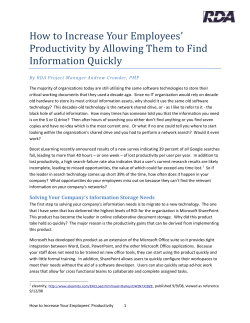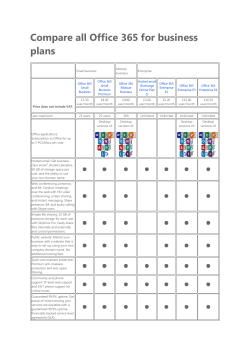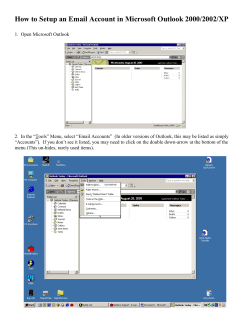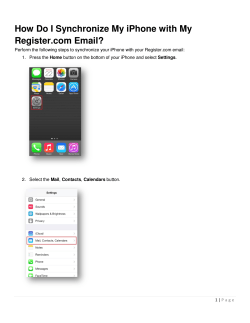
Summit: ITP14 - Tools and tips for troubleshooting Office 365
The art of troubleshooting Office 365 Kristina Ashment Program Manager Mail Flow Topology Mail Flow Review • Sending and receiving email involves many parts: −The end-user’s computer and email settings −Rules and Compliance −The SMTP servers that receive and queue up the email for relay to the recipient’s domain server −The DNS lookup for the recipient’s inbound mail server −The spam filter −The recipient’s domain servers −The recipient’s email address • When troubleshooting email, all of these factors must be taken into consideration to diagnose the issue. Common email connection problems • DNS records for your organization aren’t set up. • DNS records for your organization need to be changed. • Outlook profiles are set up to use a specific server name instead of using Autodiscover. • Unsupported version of Outlook. Troubleshooting Mail flow Message trace Delivery Reports Guided Walk through Inline Request Support Message Traces • Message Traces are generated by Administrators in EAC > Mail Flow > Message trace Provide intimate detail on where a message is up to from Exchange Online point of view • Supports searching using any arbitrary email address (inbound or outbound) • Provides all recorded instances of inbound or outbound email that has been exposed to Exchange Online transport pipeline Message Trace Example 6/21/2013 3:18:54 AM FAIL The message was not delivered. Delivery Reports Email sent to another mail system Sent but no MX Record for destination* Delivery Report for tom@tailspintoys.com (tom@tailspintoys.com) All Exchange can report is that the message is out side of its reporting Submitted boundary since it is now the processing 19/06/2013 10:23 AM responsibility of the other mail system. The message was submitted. NDRs, if any, will have to be returned by the other mail system. Transferred 19/06/2013 10:23 AM The message was successfully handed off to a different email system. This is as far as we can track it. Delivery Report for tom@tailspintoys.com (tom@tailspintoys.com) Submitted 19/06/2013 10:29 AM The message was submitted. Message stays in pipeline and retries for 48 hours Pending 19/06/2013 10:32 AM This message is traveling normally. For an update, check back in a few minutes. Sent but no MX Record – two hours later Email sent internally and verified received Delivery Report for Amy Alberts (amya@ContosoT3.onmicrosoft.com) Submitted 19/06/2013 10:33 AM The message was submitted. Since the recipient is internally handled by the same mail system. Delivery can be confirmed. Delivered 19/06/2013 10:33 AM The message was successfully delivered. Service acknowledges Pending delay 19/06/2013 12:46 PM Message delivery is taking longer than expected. There may be system delays. For more information, contact your helpdesk. Sent but no MX Record – two days later Failed 6/21/2013 10:32 AM The message couldn't be delivered. An NDR will be returned by the internal Exchange service at this stage. * This scenario applies in many circumstances where the destination mail server is unresponsive. Message Trace & Delivery Reports Message Trace Delivery Report Accessed by Administrators only Users Search Scope Any arbitrary email address Only existing mailboxes Detail Level Pipeline Events and Server information Summary of when sent and final outcome if available Best used by Administrators Users Main use scenario Diagnostics and Troubleshooting Business agenda / policy - confirming delivery Message Traces are generated by Administrators in: > EAC > mail Flow > message trace for any user Delivery Reports can be generated by end users using: > OWA > options > organize email > delivery reports for only their respective mailboxes * Some features dependent on SKU Troubleshooting domains Scenario Troubleshooting steps Problems with domain verification 1. Make sure TXT or MX record is entered correctly. Wait up to 72 hours for replication of TXT or MX record update. For a list of online tools that help with troubleshooting DNS propagation, click http://www.bing.com/search?q=dns+propagation+check. 2. Use tools such as nslookup or network-tools.com to verify entries. Unable to verify domain 1. Check whether the domain already exists in Office 365. 2. Check whether part of the domain may be blacklisted. Unable to remove domain 1. Make sure that MSO ID does not use the domain. 2. Make sure that the email addresses do not use the domain. 3. Make sure that the sub-domains of the domain do not exist. Problems with DNS settings, for example, MX, email Autodiscover, or Lync Autodiscover. 1. Wait up to 72 hours. 2. Use tools such as nslookup or network-tools.com to verify entries are added correctly. Required DNS records Service Purpose Exchange Online Exchange Online Required DNS records MX record CNAME record Exchange Online TXT/SPF record Specifies that outlook.com, the domain that is used by the Office 365 mail servers, is authorized to send mail on behalf of your domain. Create this SPF record to help prevent your outgoing mail from being flagged as spam. Lync Online SRV record Helps enable federation with other instant messaging services, such as Windows Live or Yahoo! Lync Online CNAME record Autodiscover record that is used to help users easily set up a connection between the Lync desktop client and Microsoft Lync Online. Lync Online CNAME record SharePoint Online SharePoint Online A record CNAME record Autodiscover record that is used to help users easily set up a connection between the Lync mobile client and Lync Online. Routes traffic to your public-facing SharePoint Online website. Routes traffic to your public-facing SharePoint Online website. Configures email routing. Autodiscover record that is used to help users easily set up a connection between Exchange Online and the user's Outlook desktop client or a mobile email client. Delete or Restore User Mailboxes Can be deleted by: • Deleting the user account • Removing the Exchange Online License from a user • Running the Remove-Mailbox cmdlet in PowerShell Exchange Online Retains the contents for 30 days, after this time the mailbox is permanently deleted and NOT recoverable Mailboxes can be recovered (no data lost) within the 30 day retention period • Using Office 365 admin center (Deleted users section) • Or reattaching license if license was removed Use In-Place hold to delete mailbox but retain contents. Message Limits Size Limits Limit Value Message size limit 25 MB File attachments limit 125 attachments Subject length limit 255 characters Recipient limit (in single email) 500 recipients Message Rate Limit 30 messages per minute Recipient Rate limit 10,000 recipients per 24 hours Forward Limit (applies to rules) 10 recipients. Nothing forwarded if exceeded. Retention Limits Deleted Items Items removed from Deleted items Junk Email folder 30 days 14 days 30 days • • You can't modify most of these limits, but you and your users should be aware of them. These limits apply to both internal and external recipients. The slowest 1% of pages in SharePoint online take more than 5,000ms to load 1,000ms 5,000ms Why SharePoint pages get slow… CDN Server Browser Network Server Network Microsoft Network ISP Internet Complex pages Too many web parts Expensive server interactions Front end cache misses Large payload Too many files Large distance to server Complex pages Busy computer Small cache Top 5 causes of slow performance Front end caches in SPO SharePoint On-premises 10s of servers 10s of busy sites 100s of users SharePoint Online 1,000s of servers 1,000s of busy sites 10,000s of users Perf tips: Structural Navigation • • • Fewer sites, less work Will reduce server time but still have slower requests in higher percentiles (cache misses) • • Uses managed metadata – much faster than iterating over all sites No security trimming in navigation • • Uses a search query to get site structure Can cache navigation in client storage • • Perf tips: Content rollup • • • Less scope, less work Will reduce server time but still have slower requests in higher percentiles (cache misses) • • • New in SPO! Uses search queries to get results Very rich functionality with search customization • For content that seldom changes, use static content Common links, department sites, etc. • • • Perf tips: Image optimization • • • Compress images before uploading them to SharePoint Use renditions • • Very valuable in high-latency scenarios Focus on first loading “above the fold” content before content deeper in the page • Perf tips: Optimize HTTP traffic • • • • Deliver static content via CDN’s if possible Parallelize downloads across multiple hostnames Bundle static assets together to reduce HTTP requests • • Minify all JavaScript and CSS assets Use image sprites for common static images • Troubleshooting OneDrive Issue Details Credentials required Some circumstances may require you to re-enter your log-in credentials for a library you’re syncing on your computer. When a library requires your credentials, an exclamation point icon overlays the OneDrive for Business icon in your system tray OneDrive for Business can sync up to 20,000 items in the OneDrive for We can’t sync this library Business library, including folders and files. For other libraries, such as libraries because it’s too large on team sites, OneDrive for Business can sync up to 5000 items, including folders and files. This library isn’t available Options set for this library by your administrator prohibit users from syncing it offline to a local computer. For more information, see your SharePoint administrator. This site isn’t available offline This library is hosted on a SharePoint site that prohibits syncing libraries to a local computer. For more information, see your SharePoint administrator. Demo Guided Walkthrough OneDrive for Business – Initial Sync Setup Guide http://aka.ms/odbsyncsetup OneDrive for Business Sync App (formerly SkyDrive Pro) – Sync Issues Guide http://aka.ms/odbsyncissues Additional Troubleshooting Tools Office Admin Center - Tools DIY Troubleshooter Remote Connectivity Analyzer Office Configuration Analyzer http://aka.ms/offcat Complete list of tools by SKU Guided Walkthroughs by Area: Complete list located http://support.microsoft.com/kb/ 2934107 Office Configuration Analyzer Tool (OffCAT) http://aka.ms/offcat Resources O365 Community O365 Product Blog Office Configuration Analyzer Tool (OffCAT) O365 Community Deliver a vibrant community experience that enables our customers and partners to efficiently find information, and receive best-in-class support. Forums DIY - Troubleshooter O365 DIY Community Self help tool to help customers walk through issues and identify solution assets Forums Logged in Customers can post questions, Anonymous users can view questions Wiki Wikis Knowledge based articles on specific support topics Blogs *Search Blogs http://community.office365.com/en-us/default.aspx Community Manager blogs on timely and relevant topics Searching within the Community displays ranked and rated help content from various MS properties including: Office.com & O365 Community in an easily consumable format Office 365 team blog Latest news, tips and videos from the Office 365 team at Microsoft Useful information and case studies which can be used for internal and customer purposes http://blogs.office.com/b/microsoft_office_365_blo g/ Office 365 Product Pages Useful FAQ and product information Not specific, but a good place to get highlevel information on the different plans etc. www.microsoft.com/office365 TechNet De facto source for technical product information Should be one of the first resources you refer to for technical product information Service descriptions the “bible” of Office 365 http://aka.ms/o365technet Thank you Appendix NDR Diagnostic Evaluation Diagnostic information should be read from bottom to top. The significant information that is included is as follows: Generating server: the server that sends the NDR Enhanced Status Code: the code that defines the reason for the error and points to possible causes Time between servers, known as Hop delays, that may signal latency or connectivity issues The message on the next slide shows the following: The message was sent on April 6, at 10:23:36 (EDT), and the NDR was returned on April 6, at 14:24:35 (PDT) or 10:24:25 EDT, for a total time of 49 seconds. Diagnostic Info Example Diagnostic information for administrators: Generating server: contoso.com tony@contoso.com cdptpa-contoso.mail.com #550 5.1.1 - Invalid mailbox: tony@contoso.com ## The message was sent on April 6, at 10:23:36 (EDT), and the NDR was returned on April 6, at 14:24:35 (PDT) or 10:24:25 EDT, for a total time of 49 seconds. What Do Error Codes Mean? • Error codes that indicate a persistent transient failure begin with a 4. Error codes that indicate a permanent failure begin with a 5. Some common error codes are as follows: • Issues on the sender side: 5.1.1: Bad destination. This typically occurs when the sender misspells the recipient’s address or uses the autocomplete function after an email address has changed. 5.2.3: Message too large. The outgoing message, usually because of attachments, exceeds the limit set by the Exchange administrator. • Domain server issues: 5.0.0: HELO/EHLO requires a domain address. SMTP commands are sent back and forth between the sending and receiving server. When the sending server does not receive a response, this error code is generated. • Issues on the receiver side: 5.2.2: Mailbox full–recipient has exceeded the storage quota.
© Copyright 2025










